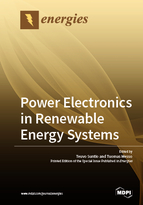Power Electronics in Renewable Energy Systems
A special issue of Energies (ISSN 1996-1073). This special issue belongs to the section "A: Sustainable Energy".
Deadline for manuscript submissions: closed (20 December 2018) | Viewed by 118579
Special Issue Editors
Interests: power electronics; dynamic modeling; control design; renewable energy; photovoltaic energy system; battery energy storage; DC-DC converter; three-phase converter
Special Issue Information
Dear Colleagues,
The renewable-energy-based generation of electricity is currently experiencing rapid growth in electric grids. The dynamics of electric grid are starting to change due to the large-scale integration of power electronic converters into the grid for facilitating the utilization of the renewable energy. Therefore, the stability and power quality of the grid have become a significant concern. This Special Issue of Energies, “Power Electronics in Renewable Energy Systems”, is intended for disseminating new promising methods and techniques to maintain the stable operation of the grid with sufficient power quality.
Prospective authors are invited to submit original contributions, survey papers or tutorials for review for publication in this Special Issue. Topics of interest include, but are not limited to:
- Stability and modeling of large grid-connected PV and Wind power plants
- Dynamic modeling and control design of renewable energy converters in grid-feeding, supporting, and forming modes
- Impedance-based grid-interactions studies
- Issues related to control, stability, diagnostics and interfacing of energy-storages in renewable energy systems
- Voltage and frequency control of grid with high penetration of renewable distributed generation
Prof. Dr. Teuvo Suntio
Prof. Dr. Tuomas Messo
Guest Editors
Manuscript Submission Information
Manuscripts should be submitted online at www.mdpi.com by registering and logging in to this website. Once you are registered, click here to go to the submission form. Manuscripts can be submitted until the deadline. All submissions that pass pre-check are peer-reviewed. Accepted papers will be published continuously in the journal (as soon as accepted) and will be listed together on the special issue website. Research articles, review articles as well as short communications are invited. For planned papers, a title and short abstract (about 100 words) can be sent to the Editorial Office for announcement on this website.
Submitted manuscripts should not have been published previously, nor be under consideration for publication elsewhere (except conference proceedings papers). All manuscripts are thoroughly refereed through a single-blind peer-review process. A guide for authors and other relevant information for submission of manuscripts is available on the Instructions for Authors page. Energies is an international peer-reviewed open access semimonthly journal published by MDPI.
Please visit the Instructions for Authors page before submitting a manuscript. The Article Processing Charge (APC) for publication in this open access journal is 2600 CHF (Swiss Francs). Submitted papers should be well formatted and use good English. Authors may use MDPI's English editing service prior to publication or during author revisions.
Keywords
- stability
- dynamics
- grid-forming operation
- grid-feeding operation
- grid-supporting operation
- solar energy
- wind energy
- energy storage
- impedance interactions






